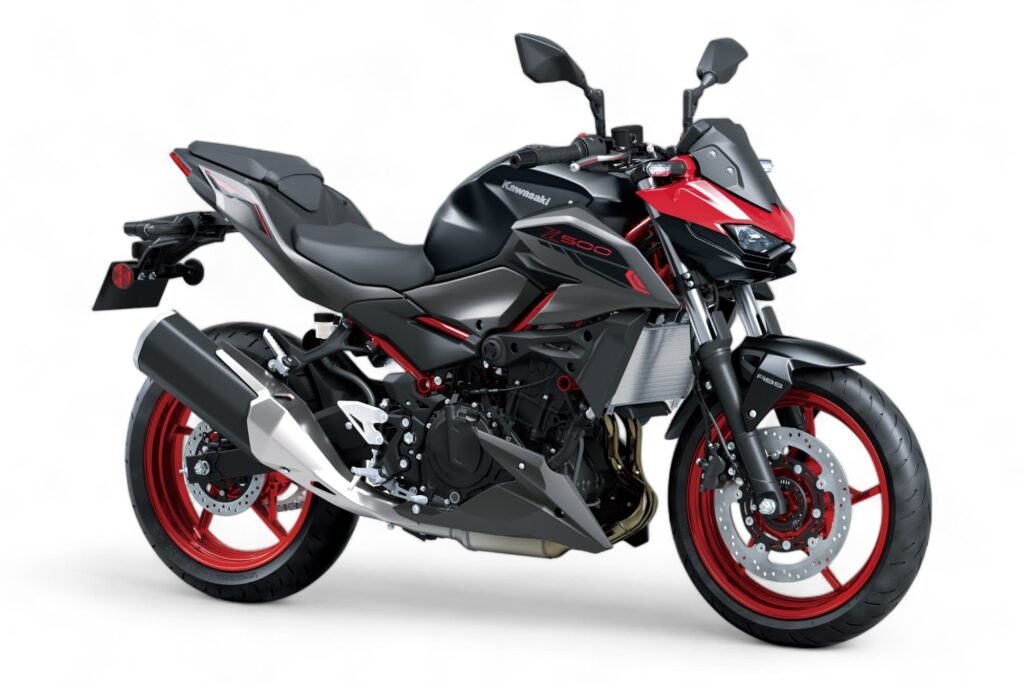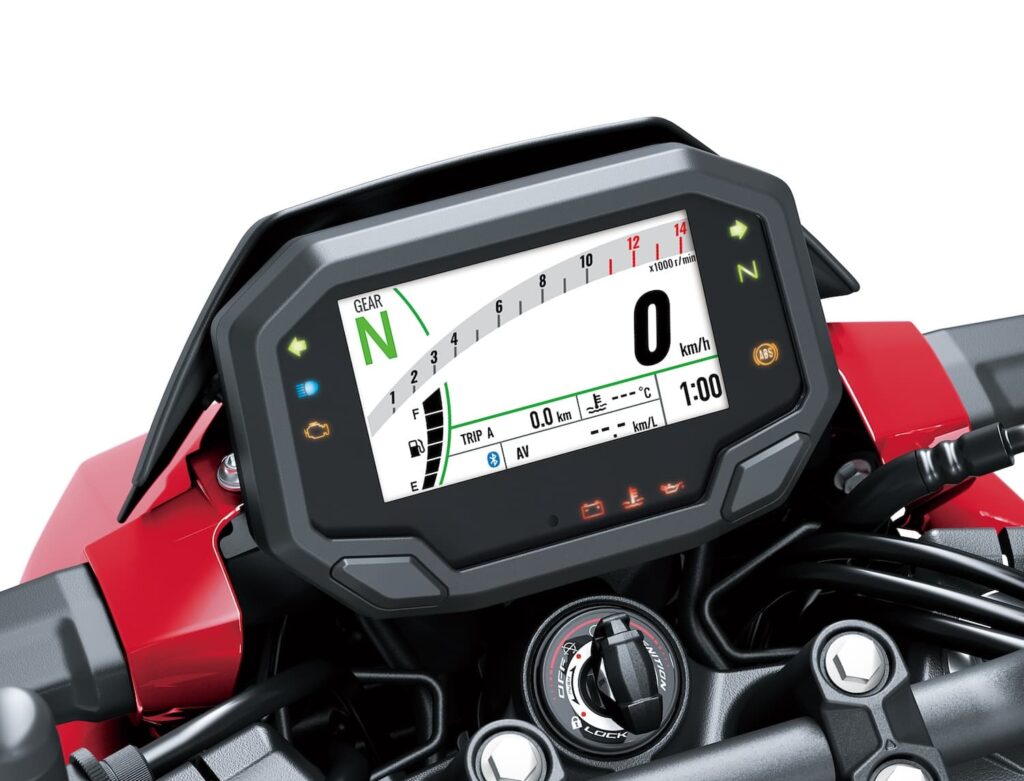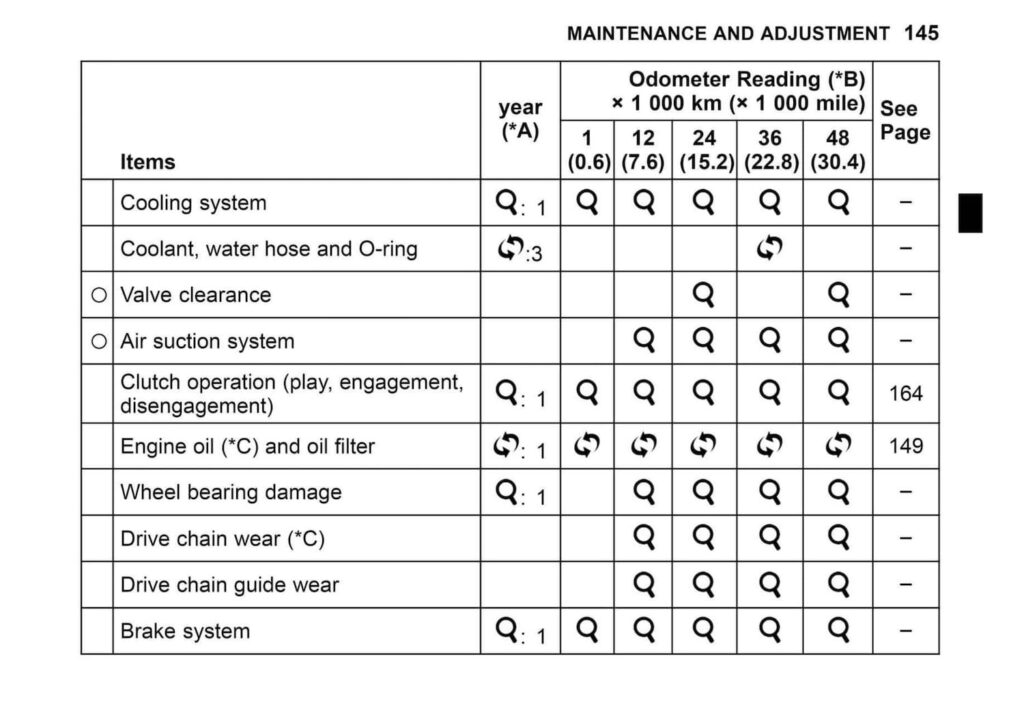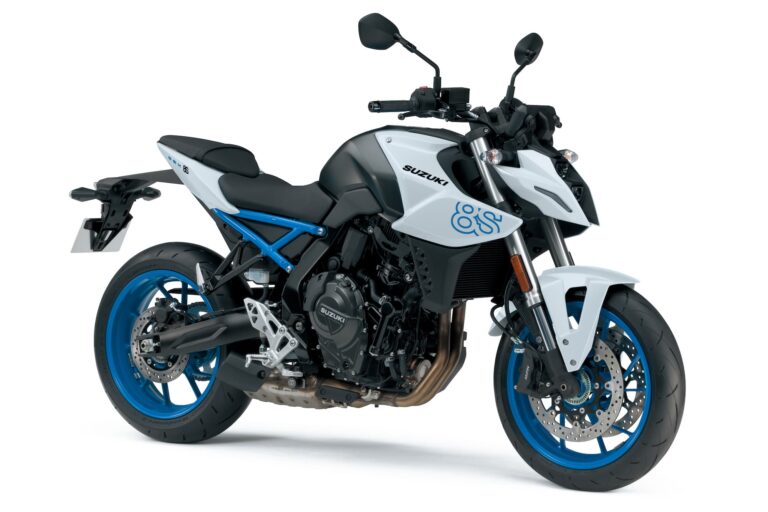Kawasaki Z500 (ER500) Complete Maintenance Schedule
This is the full maintenance schedule for the 2024 Kawasaki Z500 (ER500), a naked bike that’s a successor to the very popular Kawasaki Z400, made between 2018 and 2023, and a sibling to the 2024 Kawasaki Ninja 500.
The Z500, like its predecessor, is an entry-level naked sport bike powered by a feisty parallel twin motor. It makes around the same peak power as the Z400 (slightly less… but who’s counting), but makes significantly more midrange torque thanks to the larger-displacement 451 cc motor that makes peak power of 33.4 kW (45 hp) at 9000 rpm, and peak torque of 42.6 Nm (31.4 lb-ft) at 6000 rpm. Final drive is via a 6-speed box and chain drive, as before.
This site has links for things like oil and spark plugs from which we earn a commission (which unfortunately nobody can save, not even us). If you appreciate this work, then please use those links. Thanks!
Kawasaki Z500 Service Intervals
The Z500’s ervice interval is every 7600 miles (12000 km) OR year. At the earlier of those periods (time or distance) you must change the oil and filter, and check the inspection schedule to see what you need to adjust inspect, lubricate, or replace.
The Kawasaki Z500’s valve clearance inspection intervalis every 15000 miles (24000 km). The parallel-twin engine is easy to service, too, as there’s just one cylinder head, and there’s no need to drop the oil to do a valve service.
Aside from those items, make sure to periodically check and refresh the brake fluid and engine coolant.
Finally, pay attention to the chain. As the Z400 is a bike likely to be a daily commuter used in all kinds of conditions, its chain is bound to be subject to a lot of stress.
What you need to service your Kawasaki Z500
Like other entry-level Kawasaki Z bikes, the Z500 is easy to service. You just need a few motorcycle maintenance tools, some floor space, and of course, the following consumables.
The following parts are shared with the closely-related 2024 Ninja 500.
| Part | Kawasaki Ninja 500 & Z500 Spec |
|---|---|
| Oil | Use 2.3L (2.4 US qt) of SAE 10W-40 engine oil “with API SG, SH, SJ, SL or SM with JASO MA, MA1 or MA2 rating”, preferably Kawasaki 10W-40 Engine Oil, or another high-grade synthetic like Motul 7100 10W-40. Don’t over-torque the drain bolt (spec is 30 Nm/22 lb-ft per the manual) — use a torque wrench if you don’t have experience with how much torque is enough. |
| Oil filter | You can use a Hiflofiltro HF303RC oil filter which fits most Kawasaki engines. Torque for oil filter is 17.5 Nm (12.9 lb-ft) (use a torque wrench if unsure, and it’s easier on the aftermarket one) |
| Spark plugs | NGK LMAR9G, with a spark plug gap of 0.7-0.8mm (0.028-0.031 in). On most models, these should be torqued to 13 Nm or 9 ft-lb, but this needs to be confirmed. |
| Cable lubricant | Remember to lubricate your clutch cable (and brake cables if you have them) with a cable lubricant. Protect All Cable Life is a good general-purpose lubricant. |
| Chain lubricant | The chain needs to be lubricated every 600 km/400 miles (or more, if it gets wet/dirty). Motul chain paste is cheap and well-loved. |
| Brake fluid | Spec is to use DOT-4 brake fluid, e.g. Castrol DOT 4. |
| Coolant | Use nitrate-free, phosphate-free, ethylene glycol-based coolant with anti-corrosion inhibitors, e.g. Valvoline Zerex G05 |
| Grease | Use a lithium soap-based grease for all the important greasing points. |
Maintenance schedule for the Kawasaki Z500
Below is the full maintenance schedule for the 2024 Z500.
Notes:
- In the manual for the Kawasaki Z500, some items are marked as “emissions related” (more of a regulatory requirement) or to be inspected by a dealer. However, the bike is easy to service, so all this is left up to you.
- For clarity, we’ve also separated the “annual inspection” items from the regular items that need replacement less often (other than engine oil).
| km x 1000 | 1 | 12 | 24 | 36 | 48 | |
|---|---|---|---|---|---|---|
| mi x 1000 | 0.6 | 7.6 | 15.2 | 22.8 | 30.4 | Every |
| Perform annual inspection (see below) | ✓ | ✓ | ✓ | ✓ | ✓ | Year |
| Engine oil — Replace (Kawasaki 10W-40 Engine oil) | ✓ | ✓ | ✓ | ✓ | ✓ | Year |
| Oil filter — Replace (HF303RC) | ✓ | ✓ | ✓ | ✓ | ✓ | Year |
| Spark plugs (NGK LMAR9G) — Replace | ✓ | ✓ | ✓ | ✓ | ||
| Air cleaner element — Replace | ✓ | ✓ | More often if riding in dusty conditions or rain | |||
| Valve clearances — Inspect | ✓ | ✓ | ||||
| Idle speed — Inspect Target 1300 rpm, +/- 50 rpm | ✓ | ✓ | ✓ | ✓ | ✓ | |
| Engine vacuum synchronization — Check | ✓ | ✓ | ✓ | ✓ | ||
| Fuel filter — Replace | ✓ | ✓ | ||||
| Fuel hoses — Replace | 5 years | |||||
| Evaporative emission control system (if fitted) | ✓ | ✓ | ||||
| Coolant, water hoses, and O-rings — Replace all | ✓ | 3 years | ||||
| Air suction system — Inspect | ✓ | ✓ | ✓ | ✓ | ||
| Drive chain wear — Inspect | ✓ | ✓ | ✓ | ✓ | ||
| Drive chain guide wear — Inspect | ✓ | ✓ | ✓ | ✓ | ||
| Brake fluid (front and rear) — Replace (Castrol DOT 4) | ✓ | ✓ | 2 years | |||
| Brake hoses — Replace | 4 years | |||||
| Rubber parts of brake master cylinder and caliper – Replace | ✓ | 4 years | ||||
| Rear suspension system — Lubricate | ✓ | ✓ | ||||
| Steering stem bearing — Lubricate | ✓ | ✓ | 2 years |
Annual inspection
Below is the list of maintenance items for the Kawasaki Z500 — things to check / lubricate every service (per the schedule above).
| Kawasaki Z500 Annual Inspection |
|---|
| Throttle control system — Inspect (play of 2-3mm, smooth return, and no drag) |
| Brake system — Inspect function / leaks |
| Brake operation (effectiveness, play, no drag) |
| Brake fluid level — Check / top up (Castrol DOT 4) (Brake fluid level drops with pad wear) |
| Brake pad wear (not as critical at break-in) Service limit: 1.0mm at front, 1.5mm at rear Inspect more often if riding in dusty / wet conditions, or aggressively |
| Brake light switch operation — Check |
| Fuel system — Inspect (no leaks, kinks, damaged hoses) |
| Cooling system — Inspect (no leaks, kinks) |
| Coolant level — Inspect, top up as necessary (Zerex G05) |
| Clutch operation — Inspect (play, engagement, disengagement) Free play: 2-3 mm |
| Wheels and tires — Check condition (no dents, damage) |
| Wheel bearings — Check for damage / looseness |
| Tire air pressure — Check / adjust (See specs below) |
| Suspension system — Check for leaks, smooth operation Not required at break-in service |
| Steering play — Check for smooth operation, no notchiness |
| Electrical system — Check all lights, signals, and switches work |
| Chassis parts — Lubricate as necessary |
| Bolts, nuts, and fasteners — Check condition, tighten as necessary, or replace |
Maintaining Your Kawasaki Z500’s Chain
Since you’re likely to ride the Z500 in all kinds of conditions, the chain needs frequent attention — especially cleaning and lubrication.
To clean and lubricate the chain, use a good-quality chain lubricant like Motul chain paste, or a Motul chain care kit which comes with a couple of handy tools to maintain the chain.
Kawasaki recommends you follow the following chain maintenance schedule:
| Chain maintenance item | Every |
|---|---|
| Check drive chain lubrication condition, lubricating if necessary (Motul chain paste) | 400 mi / 600 km |
| Check drive chain slack, adjusting if necessary (See below) | 600 mi / 1000 km |
Notes:
- Do these items (checking/adjusting slack, and checking/applying lubrication) more often if you ride your Z500 in dusty or rainy conditions.
- Always lubricate the chain after washing the motorcycle.
To check the Z500’s chain slack, put it in neutral, onto its kickstand, and on a level surface.
Check the slack on the lower part of the chain, midway between the sprockets, and check it in multiple places (move the motorcycle forwards and backwards) as chains wear unevenly.
Slack on the Z500 is defined as the free vertical movement of the lower part of the chain. Measure it on the same part of the chain (e.g. the bottom).
Target chain slack for the Z500: 20 – 30 mm (0.8 – 1.2 in)
If the chain slack is out of spec, you need to adjust it.
Adjusting Chain Slack
To adjust the chain slack on the Z500, follow the procedure below. As when measuring chain slack, make sure that the motorcycle is on a level surface on its kickstand, in neutral, with no weight on it (don’t leave your tools there, and make sure any errant cats/children have cleared off!).
- Remove the axle’s cotter pin (refer to the image above to see what’s where). Loosen the rear axle and the adjuster lock nuts on both sides of the axle.
- Turn the chain tension adjuster nuts to tighten (or loosen, if it was set too tight) the chain. Keep checking the chain tension to see if it has come within spec.
- Keep an eye on the adjuster alignment marks on either side of the axle. Make sure that the adjustment is to the same point.
- When you’re done, tighten the axle to 98 Nm / 72 lb-ft. You’ll need a large torque wrench.
- Re-check the chain slack again to make sure it’s still within spec.
Tire sizes and pressures for the Z500
The Kawasaki Z500’s manual specifies the following tire sizes and pressures.
Stock, the Z500 ships with Dunlop Sportmax GPR tires, but it will take any street / sport tires.
| Tyre | Size | Tire pressure (cold) |
|---|---|---|
| Front | 110/70R17 M/C 54H | 200 kPa (2.0 bar) / 28 psi |
| Rear | 150/60R17 M/C 66H | 225 kPa (2.25 bar) / 32 psi |
About the Kawasaki Ninja 500 (2024 model)

Kawasaki updated the Z at the same time as they updated the Ninja, replacing the outgoing Ninja 400 with the 500.
The Kawasaki Z500 is powered by a 451 cc parallel twin — it’s not a dramatic change over the 399 cc of the Ninja 400. Yes, it has more midrange torque, and it gets there earlier than the Z400 did, but it actually makes slightly less peak power.
| Item | 2018-2023 Z400 | 2024+ Z500 |
|---|---|---|
| Engine | 399 cc parallel twin | 451 cc parallel twin |
| Compression ratio | 11.5:1 | 11.3:1 |
| Peak power | 35 kW / 48 PS @ 10000 rpm | 33.4 kW / 45 PS at 9000 rpm |
| Peak torque | 37 Nm / 28.0 lb-ft @ 8000 rpm | 42.6 Nm / 31.4 lb-ft @ 6000 rpm |
| Front suspension | 41mm conventional fork | 41mm conventional fork |
| Rear suspension | Bottom-link Uni Trak suspension, 5-way preload adjustable | Bottom-link Uni Trak suspension, 5-way preload adjustable |
| Front brakes | Single 310 mm disc, dual-piston caliper | Single 310 mm disc, dual-piston caliper |
| Curb weight | 166 kg | 171 kg |
| Display | Analogue | TFT |
| Ride aids | ABS | ABS |
The lower peak power of the Z500 isn’t noticeable though — this is a bike that mostly lives in the middle of the rev range when street riding. What’s more noticeable is if you decide to really fang it and rev it out, because while the Z400’s redline starts at 12,000 rpm, the Z500’s rpm ceiling begins at a much lower 10,500 rpm. It might catch you by surprise.
Though as you’ll notice, Kawasaki decided to replace the LCD instruments of the Z400 with the more slick and up-to-date TFT of the 500. The TFT is brighter and easier to read and brings with it some connectivity options that other, bigger bikes have been getting earlier.
The rest of the Kawasaki Z500 is familiar territory. This is an easy-to-ride naked sport bike with a reasonably comfortable riding position (if you don’t mind a little foot bend).
The ride gear of the Z remains basic, with a conventional (non-inverted) fork up front and a single disc brake — ostensibly the same elements as on the outgoing motorcycle. This means fewer points of failure, of course, and also easier maintenance in general.
When looking at the Z500 and Ninja 500, it’s hard for many riders not to favour the Ninja. Both bikes perform effectively the same, but the Ninja 500 gives more protection, which helps with higher-speed riding and when it’s cold or wet.
But the Z500 will remain a favourite of of people who prefer naked bikes — commuters or just those who want the more hooligan-like aesthetic. There are also many who eschew the plastics of sport bike replicas. The Z is more for them.
The build of the Z500 supports people who like to do their own service. The engine is mostly exposed and there’s easy access to the oil filler cap. The dual swing arm means chain lubrication and tension adjustment are easy (no special tools are required). But bodywork still has to come off when it’s time to do a valve clearance adjustment — which, thankfully is infrequent.
Reference — Screenshots from the Manual for the Kawasaki Z500
The above maintenance schedule was transcribed from the manual for the 2024 Z500, with reference to parts diagrams.
You can view the manual online at Kawasaki’s website here.
You can also view the extracted maintenance section of the Z500’s manual below for reference.

























